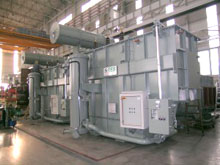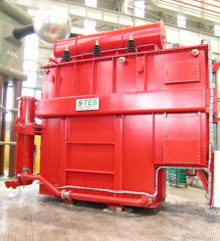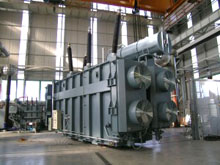|



|
.png)
Industrial Transformers
AC and DC Furnace Transformers for Metallurgy
The Electric Arc Furnace and Ladle Furnace Transformers are the key equipment in a steel plant, therefore specific engineering solutions are adopted in order to guarantee over time the best performances under the dielectric, thermal and
mechanical stresses which daily involve these transformers.
Furnaces transformer’s life is affected by heavy stresses during operation. Frequent on and off switching, high magnitude inrush currents, high operation currents, often close to short circuit values, fast transient overvoltages, significant harmonic content and elevated number of operations carried out by the on load tap changer are the everyday challenges for a furnace transformer. Electrical stresses are due to overvoltages generated both by the melting process and by transient state resulting from a sudden disconnection of HV circuit breakers, especially if vacuum-type ones are installed. Tamini pays special attention to this issue adopting a specific design and manufacturing procedures to guarantee a stronger transformer insulating structure.
Moreover during furnace operation, the transformers undergo thermal and mechanical stresses due to the continuous daily steel melting process. Continuous stresses and vibrations might make the windings loose if they are not properly treated and robustly clamped. In order to avoid any inconvenience due to such heavy and frequent stresses, Tamini has adopted improved procedures for windings pressing and thermal treatment operation.
Product scope:
• Rated power up to 360 MVA (the highest rating ever built);
• L.V. current up to 140 kA.
Tamini also provides:
• Special furnace transformers as Submerged Arc Furnace (SAF), Electroslag Remelting (ESR) and Smelter Transformers used to power furnaces for the production of special iron alloys. These alloys often require the deployment of three single-phase furnace transformers instead of a single three-phase transformer
in order to balance the total phase impedance through an equilateral-triangle layout of the units or in applications of modern steel processes.
• Regulating transformers, with either stepped or stepless regulation of the output voltage, for those applications/ processes where a fine regulation is needed.
Series Reactors for Furnace Applications
Series reactors connected to Furnace Transformer are often used to stabilize the arc current. In order to achieve better efficiency of the melting process, series reactors may have tappings to adjust the reactance in coordination with arc furnace needs.
Series reactors can be designed as Gapped-Core Reactors or Coreless Reactors (with core-frame).
Product scope:
• Up to 150 Mvar.
Reactors are used in the furnace operation with the purpose of:
• Arc stability and power regulation;
• Optimisation of electrodes consumption;
• Limitation of current during melting process;
• Reduction of flicker on the feeding network.
The reactor can be also assembled:
• Inside the main transformer tank;
• Entirely separated from the transformer;
• Located next to the transformer (On Board Reactor).
In the OBR (On Board Reactor) solution, the reactor and the
transformer are linked by a removable cable duct.
Rectifier Transformers
The rectifier transformer is the link between the electrical grid and the AC/DC converter.
Therefore, it has the aim to provide the number of phases, the voltage shifts needed to realize the conversion and to adjust the rectifier input to vary the DC output voltage.
To do it, the rectifier transformer is often coupled with components as regulating transformers (or autotransformers), saturable reactors and interphase transformers.
All these components may be assembled in one or in separate tanks for transportation optimization and site restrictions.
Product scope:
• Rated power up to 140 MVA;
• L.V. current up to 150 kA.
Rectifier Transformers face high operating currents combined with a huge amount of harmonic content due to the distorted waveform caused by the semiconductor converters connected to the transformer.
Typical applications are for: DC arc furnaces, electrolysis, scrap melting furnaces, aluminum smelter, graphitising furnaces, traction substations, metal refining and inverters for variable speed drives.
Distribution Transformers for Industrial Applications
Distribution transformers for industrial applications are used wherever it is necessary to connect systems for transmission, distribution and utilization of electrical energy, which function at different voltages, in order to transfer large quantities of active and reactive energy between these systems. Tamini’s experience has allowed the company to become a leading brand both nationally and abroad in the HV/MV distribution transformers market. The company’s products are used across a wide spectrum of applications by a plethora of major clients.
HV/MV Transformers
Distribution transformers are used to interconnect high voltage and medium voltage systems.
These transformers can be manufactured either with off-circuit tap changer or on-load tap changer and with different cooling method. Furthermore transformers for railway application with various loading guide can be manufactured as well.
Product Scope:
• System voltage up to 420 kV;
• Power rating up to 400 MVA.
MV/MV and MV/LV Distribution Transformers
Distribution transformers MV/LV type for energy distributions are usually three or single phase, oil immersed, with different cooling method (K/L) ONAN - (K/L) ONAF with detachable radiators or corrugated tank (depending on transformer size and ambient temperature), with conservator technology or sealed construction (with or without nitrogen/air filling). These transformers can be manufactured either with off-circuit tap changer or on-load tap changer, for environments with risk of explosion (ATEX) or for off-shore application. Furthermore transformers for railway application with various loading cycles can be manufactured.
Product Scope:
• System voltage up to 52 kV;
• Power rating up to 30 MVA.
For more information please visit:
www.Tamini.it
|